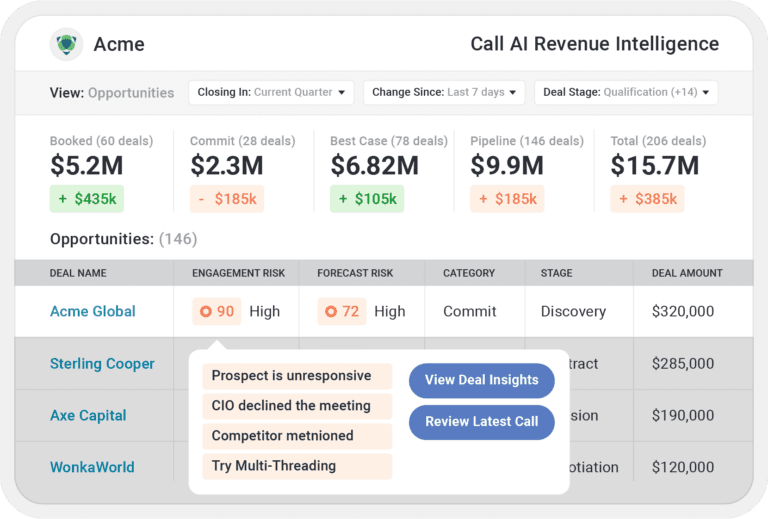Setting goals is important in all areas of life – both personally and professionally. The world of sales is no exception.
Sales goals help ensure your entire sales team is aligned. Each sales rep must understand the overall goals of the company – and the part they play in achieving those goals.
As a sales leader, it’s important to set goals that will motivate your sellers and ensure they know what’s expected of them. In theory, this seems easy enough. But in reality, setting effective goals (and then achieving them) can be challenging.
In this post, we’ll take a closer look at why sales goals are important to sales teams, how to set effective ones, examples of common sales goals, and steps you can take to track and achieve them.
What are sales goals and why are they important for your sales teams?
According to the dictionary, a goal is “an aim or desired result.”
But what are sales goals?
They are clearly defined objectives set for individual sales reps and sales teams. Sales goals articulate what the sales rep or sales team is expected to achieve within a specific amount of time.
Individual rep vs. group sales goals
Some sales goals are created for a specific sales rep. Others are developed for a subgroup of the sales team. For example, an organization might have goals for reps in specific regions – or with specific titles. Finally, some goals are developed for the sales organization as a whole.
Long-term vs. short term sales goals
Sometimes, sales goals are long-term goals. For example, a sales team might have a goal to increase revenue in their region by 20% during the fiscal year. Other goals are short-term. For example, a sales development team might have a goal to increase cold calls by 50% this month.
What are SMART sales goals?
Setting a goal like “sell as much as possible” isn’t the best approach. Instead, the most successful sales organizations use the SMART methodology to develop goals.
The idea of SMART goals was first introduced in a 1981 issue of Management Review. SMART is an acronym that guides individuals and teams in setting more effective goals. SMART goals are:
Generic goals like “close more deals” or “increase revenue” aren’t effective. Instead, goals must be specific, with details about how that goal will be achieved.
If you can’t measure something, there’s no way of knowing whether you were successful. Goals must have specific numbers attached to them.
Stretch goals are a great way to challenge reps. But goals must also be achievable.
Goals must be related to your company’s overall goals and strategy.
Goals must have a specific time attached to them. For example, close 50% more details by the end of Q2 2024.
Why are sales goals important?
Imagine you were going for a hike in the woods but had no idea where you were going and no map to guide you. Chances are, you’d lose your way at some point.
This is similar to what it’s like when sales reps don’t have sales goals.
Without goals, your sales teams don’t know what’s expected of them. They don’t know what they’re working towards – much less how to get there. In such a scenario, sellers are left to their own devices, and your chances of growing revenue are slim to none.
Creating goals is an important way to align your sales team and ensure they understand expectations. Clearly defined sales goals ensure sellers understand the overall objectives of the sales team – as well as the part they pay in achieving those objectives.
Sales goals examples
There’s no magic set of sales goals that will work for every single sales organization. Instead, it’s important to develop sales goals that make sense for your organization.
However, seeing some common, real-life examples of sales goals can be a great way to get the ideas flowing. Here are a few sales goals examples.
Generate more revenue
Reduce sales cycles
Achieve quota
Reduce churn rate
Reduce customer acquistion cost
Improve prospecting
Sales goal example #1: Generating more sales revenue
Increasing sales revenue is a top priority of any sales organization. As such, it makes sense to have a sales goal related to generating sales revenue. Because revenue is quantitative, it’s relatively easy to set a sales goal related to it.
Sales goal example #2: Reducing the sales cycle
A given deal includes several steps – from prospecting to closing the deal. Ideally, a seller would flow through these steps as quickly as possible. After all, the faster a deal goes through the sales cycle, the faster that revenue will hit the bottom line. In addition, when the deal closes, it’ll free up the rep’s time to focus on other opportunities.
- An example of a sales goal related to reducing the sales cycle might be: Reduce time to close in Q2 by 10% by focusing on good-fit prospects and delivering personalized pitches to prospects that create urgency to act.
- An example of a goal related to generating sales revenue might be: “Grow monthly recurring revenue by 25% in 2024 by improving cold calling tactics and increasing win rates.”
Sales goal example #3: Achieving quota
The more sales reps meet their sales quota, the more likely you are to reach your revenue growth goals. So it’s not surprising that sales quota achievement is a common sales goal.
- An example of a sales quota achievement goal is: “80% of sellers in the Northeast region will achieve 80% of their sales quota in Q3.”
Sales goal example #4: Reducing churn rate
It’s more expensive to win a new customer than it is to retain an existing one. As such, sales organizations must aim for a high customer retention rate.
- A sales goal example related to churn might be: “Reduce customer churn by 25% in the last two quarters of 2024 by improving client success hand-off and adopting a more proactive approach to customer success.”
Sales goal example #5: Reducing customer acquisition cost
Customer acquisition cost – often referred to as CAC – is the amount of money spent to convert a lead to a customer. This cost includes several factors, including:
- Marketing campaigns
- Your employees’ time
The longer it takes to convert a lead to a customer, the higher the CAC. As such, it makes sense to create a sales goal related to reducing CAC. An example could be: “Decrease CAC by 10% this quarter.”
Sales goal example #6: Increase cold calls and improve prospecting
Cold calls aren’t anyone’s favorite part of sales. But they’re necessary to meet sales targets.
Many sales organizations set sales goals directly related to cold call quantity. For example, “make 100 cold calls this week.”
When it comes to cold calls, it’s about both quantity and quality. Of course, you want your sellers to be making a lot of calls. But you also want them to be connecting with qualified prospects.
Tips for setting sales goals
Now that you know some common sales goals, it’s time to set your own. But how? There are some tried-and-true steps to take to get started with setting sales goals.
Step 1: Determine the type of sales goal
Step 2: Develop the goal based on the SMART methodology
Step 3: Strike the right balance between challenging and achievable
Step 4: Consider incentives
Step 5: Clearly communicate your sales goals
Step 6: Measure success of your sales goals
Step #1: Determine the type of goal
Before developing a goal, you must first determine what type of goal it is. For example, is it a goal for the entire sales team? Or is it a goal for a specific portion of your sales team or even a specific seller?
Next, determine what category of goal it is. For example, is it a sales goal related to revenue? Or perhaps you are aiming to develop a sales goal related to deal size.
Some organizations opt to start with sales goal templates. Sales goal templates can be a great starting point that can be customized to fit the needs of your business.
Remember: any sales goal you create should be aligned with your overall business strategy and objectives.
Step #2: Develop the goal based on the SMART methodology
Vague goals aren’t effective. As an example, consider a sales goal of “increase sales revenue.” Sure, this goal provides a high-level overview of the objective. However, we don’t know how much the team is aiming to increase revenue – or what the deadline is for doing so.
A better approach is to write SMART goals that are:
- Specific
- Measurable
- Achievable
- Relevant
- Time-bound
Make sure the SMART goals you set check every box on this list.
Step #3: Strike the right balance between challenging and achievable
You don’t want to set a goal so high that it’s impossible to achieve. That will only frustrate your sellers. What’s more, when these unrealistic sales goals aren’t achieved, it’ll damage morale.
But you also don’t want to set your sales KPIs too low. If your sales targets are too low, your team isn’t achieving its full potential.
Instead, it’s important to ensure your goals are challenging, yet achievable. Stretch goals are great, but they must be realistic, based on past sales data and sales enablement analytics.
Step #4: Consider incentives
Each member of your sales team should have a clear understanding of how they’re compensated based on individual and team performance. But for some sales goals, you may want to incorporate an additional incentive or reward.
Step #5: Clearly communicate your goals
Let’s say you spend time and effort developing individual and team goals. But then you don’t communicate those goals with the teams. If your sales reps don’t know their goals, how can they be expected to achieve them?
Be sure all sales reps know their individual and team goals. It’s also important to provide context for the goals. For example, a sales rep may scoff at a goal related to cold calling. However, if they understand the reason behind this goal (for example, increasing pipeline and closing more deals), they’ll be more motivated to achieve it.
Step #6: Measure progress toward your sales goals
When it comes to goals, ongoing measurement is key. Otherwise, you have no insight into whether you’re on track to achieve those sales goals.
Be sure you can easily track progress on individual and team levels. Of course, sales managers and leaders should have easy access to this information. However, it’s also important that each sales rep has insight into their progress.
Tracking and achieving your sales goals
Now that you’ve set your sales goals, it’s time to work toward achieving them. But how can you improve your chances of achieving your sales targets? Here are a few tips that can help.
Continuously measure progress toward sales goals
Let’s say you set a sales goal to increase each rep’s percentage of closed deals by the end of the quarter. But you don’t measure their progress until the last day of the quarter. If your reps fall short, there’s not much you can do at that point.
Don’t wait until the end of the goal’s specified time period to measure results. Instead, measure progress toward your sales goals on an ongoing basis. That way, you can identify challenges early on and work to correct them. Once you’ve overcome those challenges, you’ll be better equipped to achieve your sales goals.
Provide visibility into progress
Sales leadership should easily be able to access data, sales dashboards, and reports to see how their teams are progressing toward their goals. However, it’s also important to provide sales reps with visibility into progress. Seeing where they’re at in terms of achieving their sales goals can motivate them to work harder to achieve them.

Define what it takes for a sales rep to be successful
At every sales organization, there is a set of skills and competencies necessary for success. It’s important to document those competencies in an ideal rep profile (IRP). Then, measure each rep against that IRP to determine where there are gaps that need to be addressed.
Deliver training and enablement to improve key sales skills
Imagine it’s halfway through the quarter. You have a sales rep that looks like they’re going to miss their sales quota – yet again. But they’re not able to articulate what’s going wrong.
By leveraging conversation intelligence, you notice the rep is faced with a lot of objections on sales calls – and they’re having trouble overcoming those objections. There’s no doubt this is standing in the way of them achieving their sales KPIs.


Sales managers can use these insights to provide additional sales enablement and practice opportunities for this rep. For example, they assign the rep some bite-sized learning content or ask that they complete and submit some role-plays for review. In addition, the sales manager can deliver individualized coaching to help the seller boost their objection-handling skills, which will increase their likelihood of meeting their sales goals.
Recognize success toward sales goals
When your sales reps achieve their sales goals, be sure to recognize their achievement. Of course, bonuses and incentives are a great way to motivate your team. But verbal recognition can be effective, too. Remember: a little recognition can go a long way in motivating your team to continue to aim for success.
Crush your goals with Mindtickle
Setting sales goals is a foundational way to align your sales team and improve sales performance. It’s important to take the time to establish thoughtful, data-driven sales goals – and then ensure every seller has what it takes to achieve those goals.
Today, some of the best sales organizations depend on Mindtickle to crush their sales KPIs.


Mindtickle equips sales leaders with the data they need to develop and track challenging, yet realistic sales goals. In addition, sales reps can access the training, enablement, and content they need for sales success – all in one revenue intelligence platform. What’s more, Mindtickle incorporates conversational intelligence which enables sales managers to understand what’s happening in the field so they can provide coaching to improve outcomes.
Meet and Beat Your Sales Goals
Ready to see firsthand how Mindtickle can empower your entire sales team to crush its sales goals?
Get a Demo






